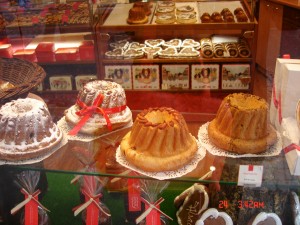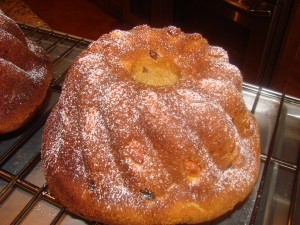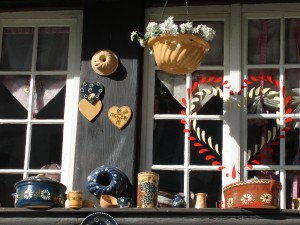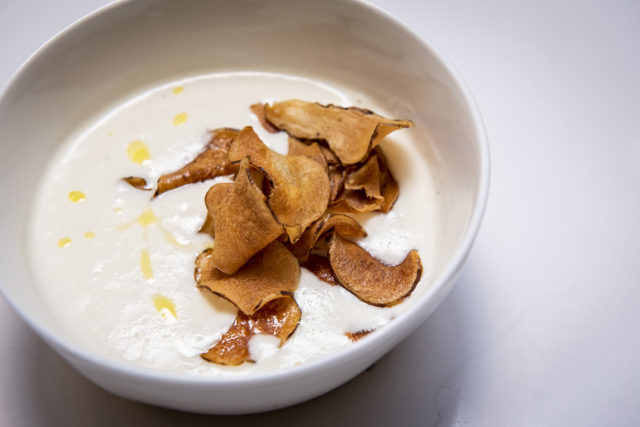The following post is brought to us by Guest Blogger Joan Ttooulias a Professional Home Economist (PHEc) in Ontario. Thanks Joan for sharing your story and recipe with us.
Every recipe has its history
I was lucky enough to be able to visit the Alsace in France; it’s a great region for food and wine, two of my favourite things. The Alsace region is now in France and has been since the end of WW11, however over the years it has been both German territory as well as being held captive by various European armies; hence the area exhibits both French and German influences.
Each Christmas I always make a festive Kugelhopf, which we eat on Christmas morning while opening the gifts. So when I was planning this trip I did some research about Kugelhopf and found that I could sample it at any of the numerous patisserie shops to be found in the Alsaceregion.
 Kugelhopf Mould
Kugelhopf Mould
Also made locally in the area are the earthenware Kugelhopf moulds, glazed and unglazed, plain and decorated, [one of the local potteries being Soufflenheim]. As the Kugelhopf moulds are readily available for purchase I of course did buy one; [hard to resist] and because of the mould’s fragile nature it had to be very carefully transported back home; which was successfully accomplished.
What is a Kugelhopf?
In Alsace it’s called Kugelhopf or Kougelhopf, in Germany ,Austria and Switzerland there are more variations of names and recipes then Elgar [British composer] ever thought of.
Kugelhopf means ‘risen ball’; it is an enriched sweet yeasted dough studded with raisins, nuts, grated lemon peel and occasionally candied peel; and it is baked in a tall, round, ribbed decorative mould originally earthenware and now also made in aluminum, copper, non-stick material or heatproof glass [easily sourced on the web]. Kugelhopf has become a specialty of the Alsace region and every June in Ribeauvillé a town South of Strasbourg, a Kugelhopf Festive takes place; entrants vie for making the best Kugelhopf.
 History of the Kugelhopf
History of the Kugelhopf
Various theories abound about concerning the origins of the Kugelhopf, some say it originated in Austria and was made popular by Marie-Antoinette, who married Louis XVI, another story makes reference to the Three Kings who travelled through the village of Ribeauvillé in France and as a way of expressing thanks for the generous hospitality they received, the Kings baked a cake and presented it to their benefactor; a village baker called ‘Monsieur Kugel’. Another tale centres on the Hapsburg war when the Turks were defeated at the gates ofViennain 1683 and in honour of the victory the Viennese bakers made a victory cake resembling a Turks turban.
When I was visiting the Strasbourg Historical Museum in April I saw displayed in a cabinet case an earthenware Kugelhopf mould dating from the second half of the 16th century; so whatever it’s origins it is a light, sweet, yeasted bread usually served at breakfast or as a treat when the children come home for school.
How to eat a Kugelhopf
Although my favourite way to eat it, is with a glass of the local wine Gewürztraminer, nicely chilled, sitting outside one of the numerous cafes in Strasbourg; preferably one of the ones located on the cathedral square so you can gaze up at the Cathedral, that splendid structure which took over 400 years to build. And if you have walked up the 332 spiral steps to the roof of the cathedral, drunk in the marvellous views from the viewing platform and then walked down again; you need feel no guilt for enjoying this delicious treat!
 Kugelhopf Recipe
Kugelhopf Recipe
Ingredients:
2 tbsp [30 mL] non-hydrogenated canola margarine
1/3 cup [75 mL] unblanched almonds
1 tbsp [15 mL] dried breadcrumbs
3-1/2 cups [875 mL] good quality bread flour
1 cup [250 mL] lukewarm milk
2/3 cup [150 mL] canola oil
3 eggs, beaten
1/3 cup [75 mL] granulated sugar
¼ cup [50 mL] each golden and Thompson raisins, washed
2 tsp [10 mL] quick rise instant yeast
1 tbsp [15 mL] finely grated orange rind
1 tsp [5 mL] each sea salt and ground cinnamon
Directions:
The day before making the Kugelhopf, macerate the raisins in either 1 tbsp [15 mL] of rum, port, or orange juice overnight.
Generously grease the mould with the margarine and press an almond into bottom of each grove of the Kugelhopf mould; finely chop remaining almonds, set aside. Sprinkle interior of mould with the breadcrumbs [see photograph]; chill the mould in the refrigerator, this helps when dough is placed in mould not to dislodge placement of nuts.
Place all the ingredients except the chopped nuts and raisins into bowl of large mixer; use the dough hook to mix dry ingredients at low speed until all ingredients are incorporated. Increase speed to medium and mix for 10 minutes until dough is smooth, elastic and glossy. Add nuts and raisins for the last minute of mixing time.
Transfer dough into prepared mould with wet hands [dough is sticky and if you run your hands under cold water and then pick up the dough to transfer it to the mould, the dough won’t stick to your hands; a very useful tip]. Dough should half fill the mould [see photograph]. Cover mould with a damp tea towel and leave to rise in a draught-free area free for about 35 to 45 minutes or until dough has risen to within ¾-inch [2 cm] of mould rim.
Bake in a pre-heated 400°F [200°C] oven for 35 to 45 minutes, or until fine metal skewer inserted into loaf comes out clean. [If using a metal mould reduce baking time by 10 minutes]. Check the Kugelhopf after 30 minutes and if top is getting too brown, cover with foil for remainder of baking time.
Cool Kugelhopf cool for a few minutes on cooling rack before turning out [see photograph]. Allow to cool completely and dust with icing sugar before serving. However if you can’t wait its delicious warm thought a bit tricky to slice; use a sharp serrated knife.
Tip: a perfect short cut for macerating raisins: place washed raisins in a small microwave safe bowl. Add your preferred choice of alcohol or orange juice. Cover bowl with plastic wrap and microwave at 50% power for 2 min. Cool mixture before adding to the dough.
Another tip: sliced Kugelhopf lightly toasted is delicious for breakfast or with a cup of coffer or tea.
Yield: makes one 10-inch [26 cm] Kugelhopf mould
Eat Well…Joan
 Joan Ttooulias is a Professional Home Economists, food stylists, recipe developer and loves to travel. On Christmas morning, she will be enjoying a piece of Kugelhopf with a chilled glass of Gewürztramine.
Joan Ttooulias is a Professional Home Economists, food stylists, recipe developer and loves to travel. On Christmas morning, she will be enjoying a piece of Kugelhopf with a chilled glass of Gewürztramine.




Comments are closed.